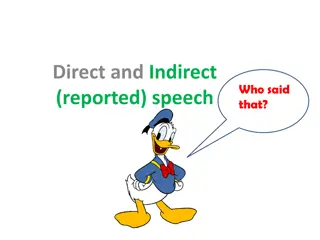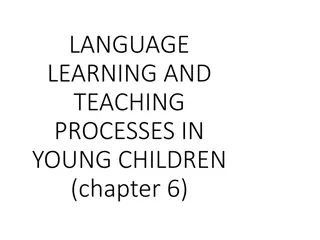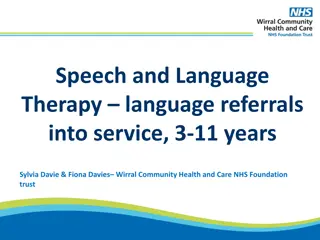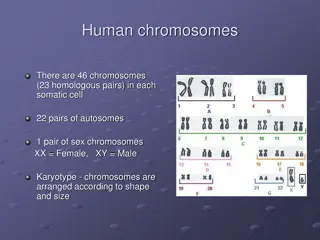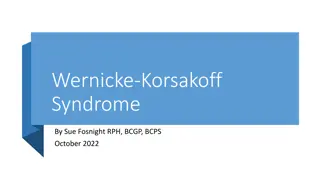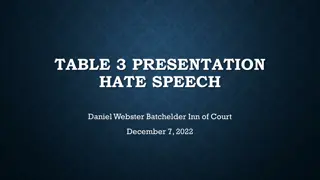Understanding Speech and Language Development in Children with Down Syndrome
Speech and language play a crucial role in the social, emotional, and cognitive development of children, particularly those with Down Syndrome. Early intervention is key for successful language acquisition, as evidence suggests that the brain is most receptive to learning between birth and 6-8 years old. Parents and professionals should be aware of the importance of supporting language development in children with Down Syndrome to promote effective communication skills.
Download Presentation

Please find below an Image/Link to download the presentation.
The content on the website is provided AS IS for your information and personal use only. It may not be sold, licensed, or shared on other websites without obtaining consent from the author. Download presentation by click this link. If you encounter any issues during the download, it is possible that the publisher has removed the file from their server.
E N D
Presentation Transcript
Click to add text Speech and Language Issues For Babies and Pre-school age children who have Down Syndrome
The importance of speech and language One of the most important things children learn to do Critical to social, emotional and cognitive development Allows control over their social and emotional world Enables children to relate to others Underpins the development of friendships Plays a huge part in enabling children to negotiate their way through the world Once stringing words together, words take over as our most powerful way to reason and remember Click to add text
Evidence suggests that the brain is most ready for speech and language learning between birth and 6-8yrs Click to add text The ability to fully master grammar and phonology may reduce after this time. (There is however, NO evidence that speech and language cannot steadily progress into adult life. Full control over grammar and phonology becomes less likely if some control is not in place by 6yrs old. Speech and language therapy please!
Some observers believe that the development of grammar is triggered by the number of words a child can understand and use. The brain begins to analyse regularities in both grammar and phonology. It is thought that the brain is most ready to do this from 3-8 years. Click to add text If the child does not have a sufficient vocabulary by this age it is possible that this analytical and computational system may not be activated. The reason for this information is to highlight for both parents AND professionals the importance of early language intervention.
Babies with DS find it more difficult to maintain their attention Be responsive and follow your child s lead, talking about what they are already interested in Most children with DS understand a lot more than they can say Vast majority of children with DS are late in starting to talk Average age for first spoken word about 18 months. First ten words 27 months Tend to start using two words together when they have a productive vocabulary of about 50 words occurs on average at around 37 months Click to add text
Facts. Speech is more delayed than it should be according to their cognitive abilities Speech and language motor work is necessary Children who have DS have difficulties with their short term verbal memory Signing is helpful Click to add text
Signing. Enables a child with no speech to communicate Will reduce frustration and/or withdrawal Encourages two-way communication with the child before speech is in place Encourages your child to look at you during exchanges of communication Emphasises words and gives visual backup to auditory information Illustrates different meanings for words which sound the same. Click to add text
Language Assessments. These should take place in a variety of contexts eg home, playschool/nursery, with different adults, with other children etc. Should be an ongoing gathering of information Should be an exchange of information with parents. Click to add text Should take into account the child s signing vocabulary
A number of parent-oriented interventions have demonstrated that communication intervention in the first 3 years of life fosters pre-linguistic and/or early linguistic skills in individuals with D.S. Click to add text
Target word teaching Same research team who developed Hanen programme carried out studies with parents teaching their children specific target words for specific lengths of time Eg a group of children aged between 29-46 months (all had at least 10 signs) were taught 10 words Parents set up new routines to make it easy to use and model the words frequently repeating the word three times during each interaction. Child not required to imitate at this point The children learned and used more words more quickly than the control group who were still playing with mum and getting regular speech and language therapy. Click to add text
Reading Current evidence strongly suggests that teaching children with D.S. a sight vocabulary should be a routine part of their speech and language therapy programme as well as a priority in any early intervention programme. Learning to read will visually support grammar and sentence learning. 3-4 years is usually optimum age to start Matching words Click to add text
Things to remember. Matching words Good and simple use of language Looking at lots of books together and reading to your child Rhyme, rhythm, repetitive, catchphrase/chorus As much eye contact as possible Singing Exaggerated facial expressions Make your own picture cards Color cards for identification, speech production exercise and later word recognition Press the letter toys Click to add text


![❤[PDF]⚡ Zee Zee Does It Anyway!: A Story about down Syndrome and Determination](/thumb/20462/pdf-zee-zee-does-it-anyway-a-story-about-down-syndrome-and-determination.jpg)




